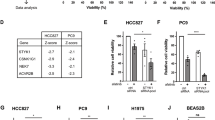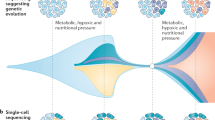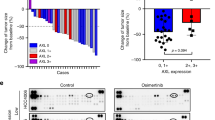Abstract
Although mechanisms of acquired resistance of epidermal growth factor receptor (EGFR)-mutant non-small-cell lung cancers to EGFR inhibitors have been identified, little is known about how resistant clones evolve during drug therapy. Here we observe that acquired resistance caused by the EGFRT790M gatekeeper mutation can occur either by selection of pre-existing EGFRT790M-positive clones or via genetic evolution of initially EGFRT790M-negative drug-tolerant cells. The path to resistance impacts the biology of the resistant clone, as those that evolved from drug-tolerant cells had a diminished apoptotic response to third-generation EGFR inhibitors that target EGFRT790M; treatment with navitoclax, an inhibitor of the anti-apoptotic factors BCL-xL and BCL-2 restored sensitivity. We corroborated these findings using cultures derived directly from EGFR inhibitor–resistant patient tumors. These findings provide evidence that clinically relevant drug-resistant cancer cells can both pre-exist and evolve from drug-tolerant cells, and they point to therapeutic opportunities to prevent or overcome resistance in the clinic.
This is a preview of subscription content, access via your institution
Access options
Subscribe to this journal
Receive 12 print issues and online access
$209.00 per year
only $17.42 per issue
Buy this article
- Purchase on SpringerLink
- Instant access to full article PDF
Prices may be subject to local taxes which are calculated during checkout





Similar content being viewed by others
Accession codes
References
Mok, T.S. et al. Gefitinib or carboplatin-paclitaxel in pulmonary adenocarcinoma. N. Engl. J. Med. 361, 947–957 (2009).
Maemondo, M. et al. Gefitinib or chemotherapy for non-small-cell lung cancer with mutated EGFR. N. Engl. J. Med. 362, 2380–2388 (2010).
Camidge, D.R., Pao, W. & Sequist, L.V. Acquired resistance to TKIs in solid tumors: learning from lung cancer. Nat. Rev. Clin. Oncol. 11, 473–481 (2014).
Sequist, L.V. et al. Genotypic and histological evolution of lung cancers acquiring resistance to EGFR inhibitors. Sci. Transl. Med. 3, 75ra26 (2011).
Pao, W. et al. Acquired resistance of lung adenocarcinomas to gefitinib or erlotinib is associated with a second mutation in the EGFR kinase domain. PLoS Med. 2, e73 (2005).
Engelman, J.A. et al. MET amplification leads to gefitinib resistance in lung cancer by activating ERBB3 signaling. Science 316, 1039–1043 (2007).
Turke, A.B. et al. Preexistence and clonal selection of MET amplification in EGFR-mutant NSCLC. Cancer Cell 17, 77–88 (2010).
Bhang, H.E. et al. Studying clonal dynamics in response to cancer therapy using high-complexity barcoding. Nat. Med. 21, 440–448 (2015).
Su, K.Y. et al. Pretreatment epidermal growth factor receptor (EGFR) T790M mutation predicts shorter EGFR tyrosine kinase inhibitor response duration in patients with non-small-cell lung cancer. J. Clin. Oncol. 30, 433–440 (2012).
Ye, X. et al. High T790M detection rate in TKI-naive NSCLC with EGFR-sensitive mutation: truth or artifact? J. Thorac. Oncol. 8, 1118–1120 (2013).
Sharma, S.V. et al. A chromatin-mediated reversible drug-tolerant state in cancer cell subpopulations. Cell 141, 69–80 (2010).
Lee, H.J. et al. Drug resistance via feedback activation of Stat3 in oncogene-addicted cancer cells. Cancer Cell 26, 207–221 (2014).
Wilson, T.R. et al. Widespread potential for growth factor–driven resistance to anticancer kinase inhibitors. Nature 487, 505–509 (2012).
Crystal, A.S. et al. Patient-derived models of acquired resistance can identify effective drug combinations for cancer. Science 346, 1480–1486 (2014).
Zhou, W. et al. Novel mutant-selective EGFR kinase inhibitors against EGFRT790M. Nature 462, 1070–1074 (2009).
Hata, A.N., Engelman, J.A. & Faber, A.C. The BCL2 family: key mediators of the apoptotic response to targeted anticancer therapeutics. Cancer Discov. 5, 475–487 (2015).
Cragg, M.S., Kuroda, J., Puthalakath, H., Huang, D.C. & Strasser, A. Gefitinib-induced killing of NSCLC cell lines expressing mutant EGFR requires BIM and can be enhanced by BH3 mimetics. PLoS Med. 4, 1681–1689, discussion 1690 (2007).
Costa, D.B. et al. BIM mediates EGFR tyrosine kinase inhibitor–induced apoptosis in lung cancers with oncogenic EGFR mutations. PLoS Med. 4, 1669–1679 discussion 1680 (2007).
Gong, Y. et al. Induction of BIM is essential for apoptosis triggered by EGFR kinase inhibitors in mutant EGFR-dependent lung adenocarcinomas. PLoS Med. 4, e294 2007).
Faber, A.C. et al. BIM expression in treatment-naive cancers predicts responsiveness to kinase inhibitors. Cancer Discov. 1, 352–365 (2011).
Robasky, K., Lewis, N.E. & Church, G.M. The role of replicates for error mitigation in next-generation sequencing. Nat. Rev. Genet. 15, 56–62 (2014).
Hindson, B.J. et al. High-throughput droplet digital PCR system for absolute quantitation of DNA copy number. Anal. Chem. 83, 8604–8610 (2011).
Zheng, Z. et al. Anchored multiplex PCR for targeted next-generation sequencing. Nat. Med. 20, 1479–1484 (2014).
Ohashi, K. et al. Lung cancers with acquired resistance to EGFR inhibitors occasionally harbor BRAF gene mutations but lack mutations in KRAS, NRAS or MEK1. Proc. Natl. Acad. Sci. USA 109, E2127–E2133 (2012).
Eberlein, C.A. et al. Acquired resistance to the mutant-selective EGFR inhibitor AZD9291 is associated with increased dependence on RAS signaling in preclinical models. Cancer Res. 75, 2489–2500 (2015).
Piotrowska, Z. et al. Heterogeneity underlies the emergence of EGFRT790 wild-type clones following treatment of T790M-positive cancers with a third-generation EGFR inhibitor. Cancer Discov. 5, 713–722 (2015).
Jänne, P.A. et al. AZD9291 in EGFR inhibitor–resistant non-small-cell lung cancer. N. Engl. J. Med. 372, 1689–1699 (2015).
Sequist, L.V. et al. Rociletinib in EGFR-mutated non-small-cell lung cancer. N. Engl. J. Med. 372, 1700–1709 (2015).
Cross, D.A. et al. AZD9291, an irreversible EGFR TKI, overcomes T790M-mediated resistance to EGFR inhibitors in lung cancer. Cancer Discov. 4, 1046–1061 (2014).
Cragg, M.S. et al. Treatment of BRAF–mutant human tumor cells with a MEK inhibitor requires Bim and is enhanced by a BH3 mimetic. J. Clin. Invest. 118, 3651–3659 (2008).
Corcoran, R.B. et al. Synthetic lethal interaction of combined BCL-XL and MEK inhibition promotes tumor regressions in KRAS-mutant cancer models. Cancer Cell 23, 121–128 (2013).
de Bruin, E.C. et al. Spatial and temporal diversity in genomic instability processes defines lung cancer evolution. Science 346, 251–256 (2014).
McGranahan, N. & Swanton, C. Biological and therapeutic impact of intratumor heterogeneity in cancer evolution. Cancer Cell 27, 15–26 (2015).
Misale, S., Di Nicolantonio, F., Sartore-Bianchi, A., Siena, S. & Bardelli, A. Resistance to anti-EGFR therapy in colorectal cancer: from heterogeneity to convergent evolution. Cancer Discov. 4, 1269–1280 (2014).
Maheswaran, S. et al. Detection of mutations in EGFR in circulating lung cancer cells. N. Engl. J. Med. 359, 366–377 (2008).
Byers, L.A. et al. An epithelial-mesenchymal transition gene signature predicts resistance to EGFR and PI3K inhibitors and identifies Axl as a therapeutic target for overcoming EGFR-inhibitor resistance. Clin. Cancer Res. 19, 279–290 (2013).
Hirata, E. et al. Intravital imaging reveals how BRAF inhibition generates drug-tolerant microenvironments with high integrin-β1 and FAK signaling. Cancer Cell 27, 574–588 (2015).
Ramirez et al. Diverse drug-resistance mechanisms can emerge from drug-tolerant cancer persister cells. Nat. Commun. (in the press).
Thress, K.S. et al. Acquired EGFRC797S mutation mediates resistance to AZD9291 in non-small-cell lung cancer harboring EGFRT790M. Nat. Med. 21, 560–562 (2015).
Niederst, M.J. et al. RB loss in resistant EGFR-mutant lung adenocarcinomas that transform to small-cell lung cancer. Nat. Commun. 6, 6377 (2015).
Misale, S. et al. Blockade of EGFR and MEK intercepts heterogeneous mechanisms of acquired resistance to anti-EGFR therapies in colorectal cancer. Sci. Transl. Med. 6, 224ra26 (2014).
Dias-Santagata, D. et al. Rapid targeted mutational analysis of human tumors: a clinical platform to guide personalized cancer medicine. EMBO Mol. Med. 2, 146–158 (2010).
Hata, A.N. et al. Failure to induce apoptosis via BCL-2 family proteins underlies lack of efficacy of combined MEK and PI3K inhibitors for KRAS-mutant lung cancers. Cancer Res. 74, 3146–3156 (2014).
Chmielecki, J. et al. Optimization of dosing for EGFR-mutant non-small-cell lung cancer with evolutionary cancer modeling. Sci. Transl. Med. 3, 90ra59 (2011).
Tyson, D.R., Garbett, S.P., Frick, P.L. & Quaranta, V. Fractional proliferation: a method to deconvolve cell population dynamics from single-cell data. Nat. Methods 9, 923–928 (2012).
Kunkel, T.A. & Bebenek, K. DNA replication fidelity. Annu. Rev. Biochem. 69, 497–529 (2000).
Oller, A.R., Rastogi, P., Morgenthaler, S. & Thilly, W.G. A statistical model to estimate variance in long-term, low-dose mutation assays: testing of the model in a human lymphoblastoid mutation assay. Mutat. Res. 216, 149–161 (1989).
Alexandrov, L.B. et al. Signatures of mutational processes in human cancer. Nature 500, 415–421 (2013).
Lynch, M. Rate, molecular spectrum and consequences of human mutation. Proc. Natl. Acad. Sci. USA 107, 961–968 (2010).
Lawrence, M.S. et al. Mutational heterogeneity in cancer and the search for new cancer-associated genes. Nature 499, 214–218 (2013).
Dobin, A. et al. STAR: ultrafast universal RNA-seq aligner. Bioinformatics 29, 15–21 (2013).
Anders, S., Pyl, P.T. & Huber, W. HTSeq—a Python framework to work with high-throughput sequencing data. Bioinformatics 31, 166–169 (2015).
Robinson, M.D., McCarthy, D.J. & Smyth, G.K. edgeR: a Bioconductor package for differential expression analysis of digital gene-expression data. Bioinformatics 26, 139–140 (2010).
Subramanian, A. et al. Gene-set enrichment analysis: a knowledge-based approach for interpreting genome-wide expression profiles. Proc. Natl. Acad. Sci. USA 102, 15545–15550 (2005).
Mootha, V.K. et al. PGC-1α–responsive genes involved in oxidative phosphorylation are coordinately downregulated in human diabetes. Nat. Genet. 34, 267–273 (2003).
Acknowledgements
We thank C. Benes and all members of the Engelman and Benes laboratories for helpful discussions and feedback. This study was funded by support from the US National Institutes of Health (NIH) (grant R01CA137008; J.A.E.), the Department of Defense (L.V.S. and J.A.E.), LunGevity (L.V.S. and J.A.E.), Uniting Against Lung Cancer (A.N.H. and M.J.N.), the Conquer Cancer Foundation of the American Society of Clinical Oncology (A.N.H.), the Lung Cancer Research Foundation (M.J.N.), Targeting a Cure for Lung Cancer (J.A.E.), Be a Piece of the Solution (J.A.E.), and the John and Carol Barry Foundation (A.N.H.).
Author information
Authors and Affiliations
Contributions
A.N.H., M.J.N. and J.A.E. designed the study, analyzed the data and wrote the paper. A.N.H., M.J.N., H.L.A., M.G.-C., F.M.S., H.E.M., H.H. and L.J.D. performed cell line and biochemical studies. M.G.-C. and C.C. performed tumor xenograft studies. E.L., A.K. and D.L. generated the patient-derived cell lines. H.C.B., V.K.R., C.L.K., D.A.R. and F.S. performed barcode analysis. Y.E.M. and G.G. performed mathematical modeling of EGFRT790M evolution. F.J. and R.I.S. performed RNA-seq analysis. A.S.C. performed combination drug screening. G.S., A.J.I. and A.B. performed genotyping analysis. S.R. performed mathematical modeling of emergence of RFP-resistant clones. A.C.F. was involved with study design. L.V.S. and Z.P. provided EGFR-mutated NSCLC patient samples. A.N.H. and M.J.N. contributed equally to the study. All authors discussed the results and commented on the manuscript.
Corresponding author
Ethics declarations
Competing interests
J.A.E. is a consultant for Novartis, Sanofi, Genentech, Clovis and Astra Zeneca; owns equity in Gatekeeper Pharmaceuticals, which has interest in EGFRT790M inhibitors; and has research agreements with Novartis and AstraZeneca. A.N.H. has provided consulting services for Amgen. M.J.N. has provided consulting services for Boehringer Ingelheim Pharmaceuticals. Z.P. has provided consulting services for Clovis Oncology and Boehringer Ingelheim Pharmaceuticals. L.V.S. has provided uncompensated consulting services to Clovis Oncology, AstraZeneca, Novartis, Boehringer Ingelheim Pharmaceuticals, Merrimack Pharmaceuticals, Genentech and Taiho Pharmaceuticals. H.C.B., V.K.R., C.L.K., D.A.R., A.S.C. and F.S. are employees of Novartis, Inc., as noted in the affiliations.
Supplementary information
Supplementary Text and Figures
Supplementary Figures 1–14 and Supplementary Table 1 (PDF 11937 kb)
Rights and permissions
About this article
Cite this article
Hata, A., Niederst, M., Archibald, H. et al. Tumor cells can follow distinct evolutionary paths to become resistant to epidermal growth factor receptor inhibition. Nat Med 22, 262–269 (2016). https://doi.org/10.1038/nm.4040
Received:
Accepted:
Published:
Issue Date:
DOI: https://doi.org/10.1038/nm.4040
This article is cited by
-
Primary versus acquired epidermal growth factor receptor Thr790Met mutant non-small cell lung cancer: clinical features and prognoses
Clinical and Translational Oncology (2024)
-
Clonal tracking in cancer and metastasis
Cancer and Metastasis Reviews (2024)
-
Application value of CT radiomic nomogram in predicting T790M mutation of lung adenocarcinoma
BMC Pulmonary Medicine (2023)
-
Exosome-derived circKIF20B suppresses gefitinib resistance and cell proliferation in non-small cell lung cancer
Cancer Cell International (2023)
-
Therapeutic impact of epidermal growth factor receptor tyrosine kinase inhibitor with various treatment combinations for advanced lung adenocarcinoma
World Journal of Surgical Oncology (2023)



